Easy & Moist Orange Loaf Cake with Zesty Glaze: Your Simple, One-Bowl Recipe!
Prepare to fall in love with this incredibly easy Orange Loaf Cake! It boasts a wonderfully moist and delightfully fluffy texture, infused with a vibrant, fresh citrus flavor that sings with every bite. To elevate the orange experience even further, it’s crowned with a simple yet irresistible orange icing glaze. This versatile quick bread is absolutely perfect for a delightful afternoon tea, a bright breakfast treat, or a comforting dessert. It’s a guaranteed crowd-pleaser that requires minimal effort for maximum deliciousness!
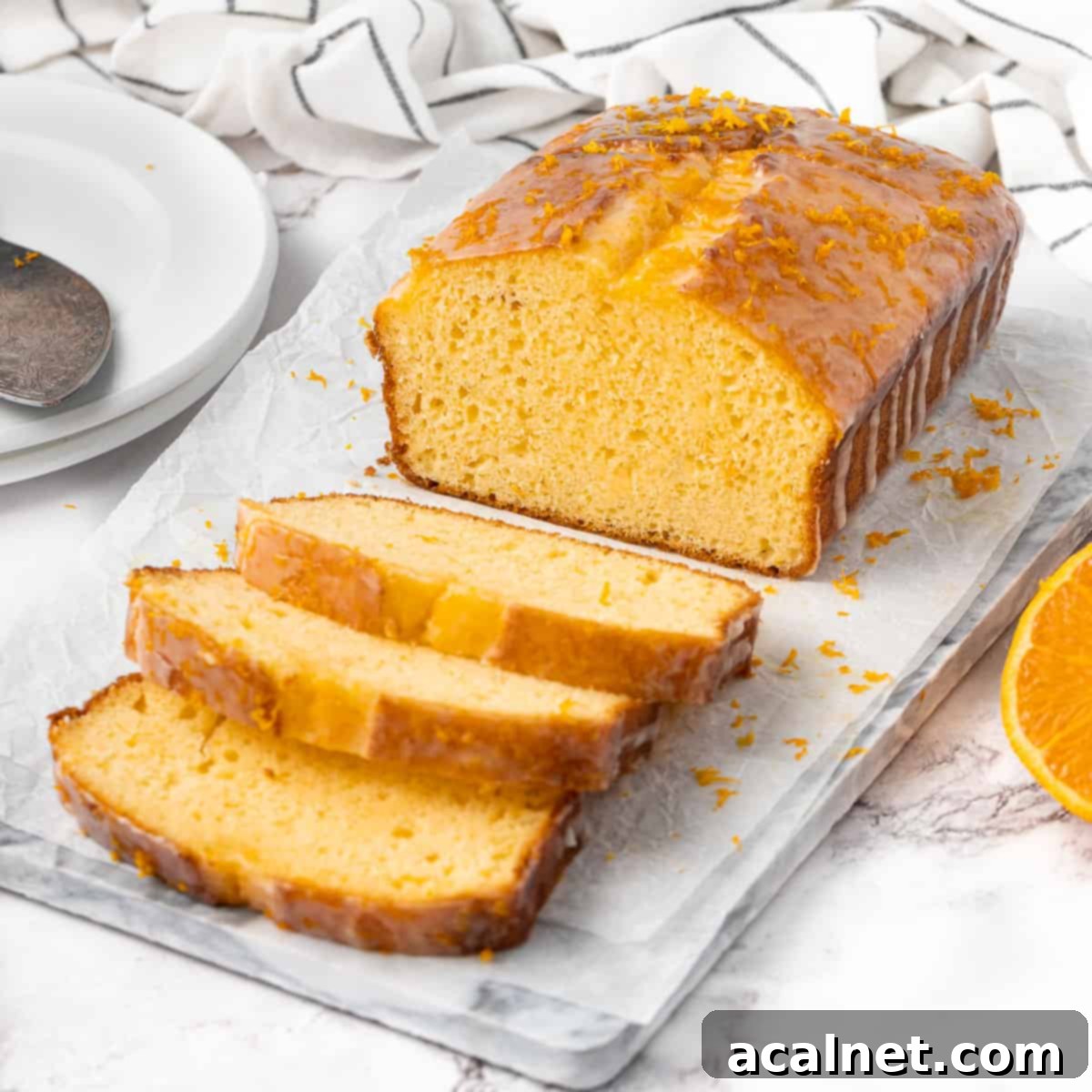
[feast_advanced_jump_to]
Why You’ll Adore This Easy Orange Loaf Cake Recipe
This orange loaf cake is more than just a dessert; it’s a testament to simple baking at its best. It’s incredibly quick and straightforward to prepare, making it an ideal choice for a spontaneous afternoon tea gathering, a delightful breakfast side, or a sweet finish to any meal. The bright, fresh, and unmistakable flavors of orange truly elevate this classic quick bread, transforming it into something truly special.
Here’s why this Orange Loaf Cake recipe stands out:
- It’s incredibly simple to make, requiring just one bowl for the batter. Forget about tedious cleanup; this recipe is designed for ease and convenience. Plus, no stand mixer or hand mixer is required – a simple whisk is all you need! This makes it perfect for beginner bakers or those short on time.
- This orange loaf is truly packed with an explosion of delicious orange flavors. We incorporate both fresh orange zest and orange juice directly into the cake batter, ensuring a deep, aromatic citrus essence throughout. The simple orange icing glaze, also made with fresh orange juice, amplifies this flavor, and a sprinkle of extra orange zest on top provides a beautiful finish and an added burst of freshness.
- The resulting loaf cake boasts an incredibly soft, light, and wonderfully fluffy crumb that is consistently moist. The secret to this superior texture and extended freshness lies in the thoughtful combination of neutral oil and creamy Greek yogurt. These ingredients work together to keep your cake tasting fresh and tender for several days, unlike cakes made solely with butter which can dry out faster.
Looking for more delightful citrus loaf cakes? You might also enjoy these: Lemon Poppy Seed Loaf Cake / Easy Lemon Drizzle Cake / Lemon Raspberry Loaf Cake.
Essential Ingredients for Your Zesty Orange Loaf
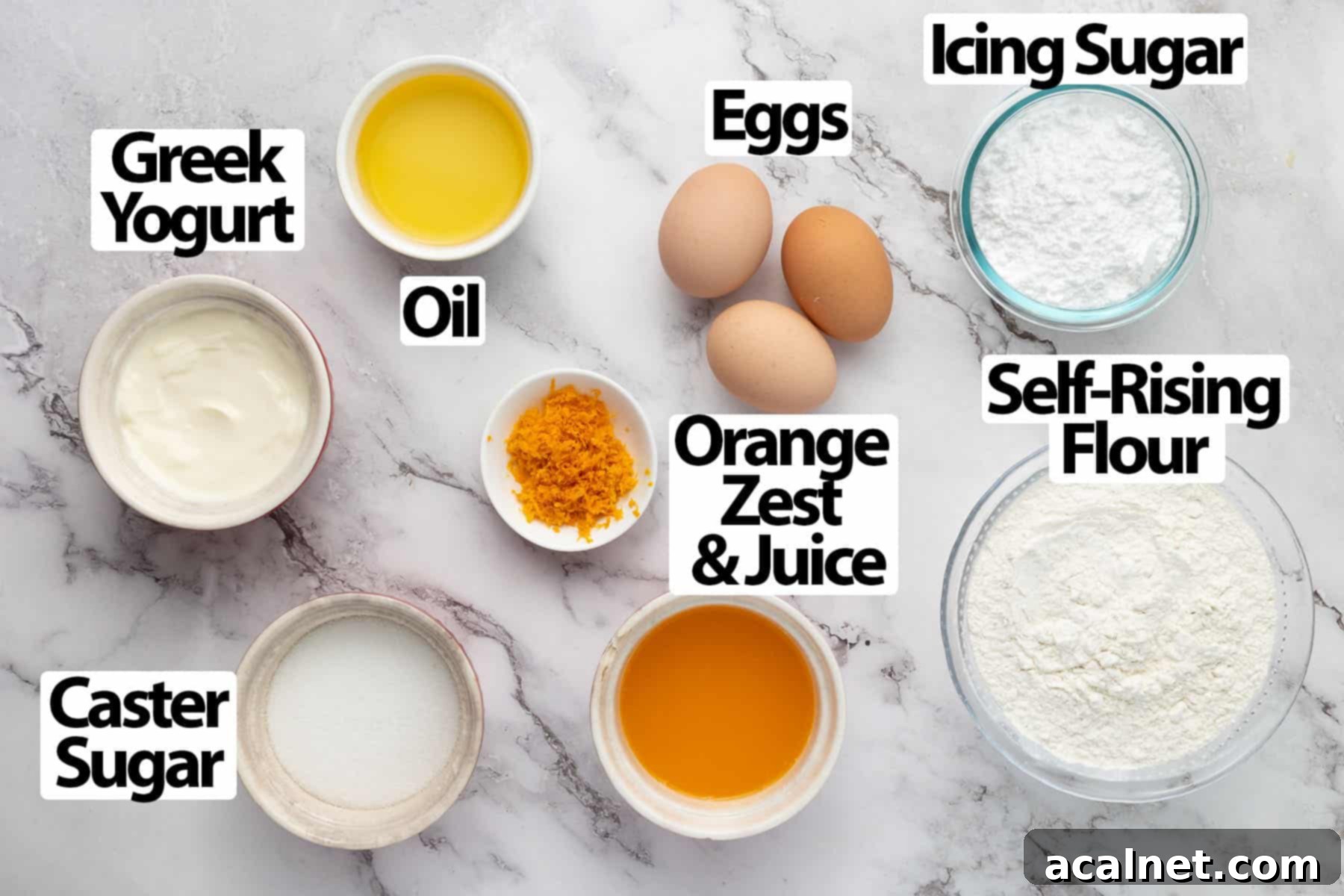
Crafting this vibrant orange cake starts with a few simple, high-quality ingredients. Here’s a breakdown of what you’ll need and why each component is important:
For precise measurements and detailed quantities, please scroll down to the full recipe card below.
For the incredibly moist orange quick bread:
- Eggs: Use large eggs, and crucially, ensure they are at room temperature. Room temperature eggs emulsify much better with other ingredients, creating a smoother batter and a more uniform, tender crumb in your final cake. Cold eggs can cause the batter to seize and result in a denser texture.
- Orange: This is where the magic happens! We harness the full power of the orange by using both its vibrant zest and fresh juice. The zest is paramount for flavor, as it contains the essential oils that deliver that intense, aromatic orange punch. For the best results, always opt for fresh orange juice; however, store-bought 100% pure orange juice (without added sugars or pulp) can work in a pinch. Remember, the more zest, the more intense and delightful your orange flavor will be!
- Oil: A neutral-flavored oil, such as canola oil, vegetable oil, or grapeseed oil, is highly recommended. Oil contributes significantly to the cake’s moistness and ensures it stays fresh and tender for longer. While melted butter can be used, it tends to yield a cake that dries out more quickly due to its lower moisture content and different fat structure compared to oil.
- Yogurt: Greek yogurt or natural unsweetened yogurt is our secret weapon for an unbelievably soft, light, and moist crumb! The acidity in the yogurt helps activate the leavening agents, while its fat and moisture content prevent the cake from becoming dry. You can substitute with sour cream for a similar effect, but many bakers find Greek yogurt imparts a lighter, more refreshing feel.
- Self-Rising Flour: For ultimate convenience, self-rising flour already contains baking powder and salt. If you prefer to use plain or all-purpose flour, please refer to the FAQs section below for simple instructions on how to create your own self-rising flour blend.
For the simple yet exquisite orange glaze:
- Icing Sugar: Also known as powdered sugar or confectioners’ sugar. It’s crucial to sift it well to prevent any lumps, ensuring a silky-smooth glaze. This recipe uses a moderate amount of sugar for a glaze, resulting in a lighter, thinner consistency that elegantly drizzles over the loaf. If you desire a sweeter, thicker icing, feel free to incrementally increase the quantity of icing sugar until your preferred consistency is achieved.
- Orange: Just like in the cake, we’ll use fresh orange juice to form the base of the icing, providing a bright, tangy counterpoint to the sweetness. And don’t forget a final sprinkle of fresh orange zest over the glazed loaf for that extra visual appeal and burst of aromatic flavor.
Optional Additions and Flavor Enhancements
- Candied Oranges: For an extra layer of texture and an even more intense orange flavor, consider folding some finely chopped candied orange peels into the batter. You can also elegantly garnish the finished orange loaf with beautiful candied orange slices.
- Lemon Zest & Juice: To introduce a delightful complexity and balance the sweeter notes of the orange, you can replace a portion of the orange juice and zest with fresh lemon juice and zest. This adds a wonderful tangy brightness.
- Nuts or Poppy Seeds: For added texture and a subtle crunch, mix in a handful of chopped walnuts, pecans, or poppy seeds into the batter before baking. These additions pair beautifully with citrus flavors.
- Spices: A touch of warm spice can complement the orange wonderfully. A pinch of ground cinnamon, cardamom, or nutmeg can be added to the dry ingredients for a cozy twist.
How to Bake Your Perfect Orange Loaf Cake (Step-by-Step Guide)
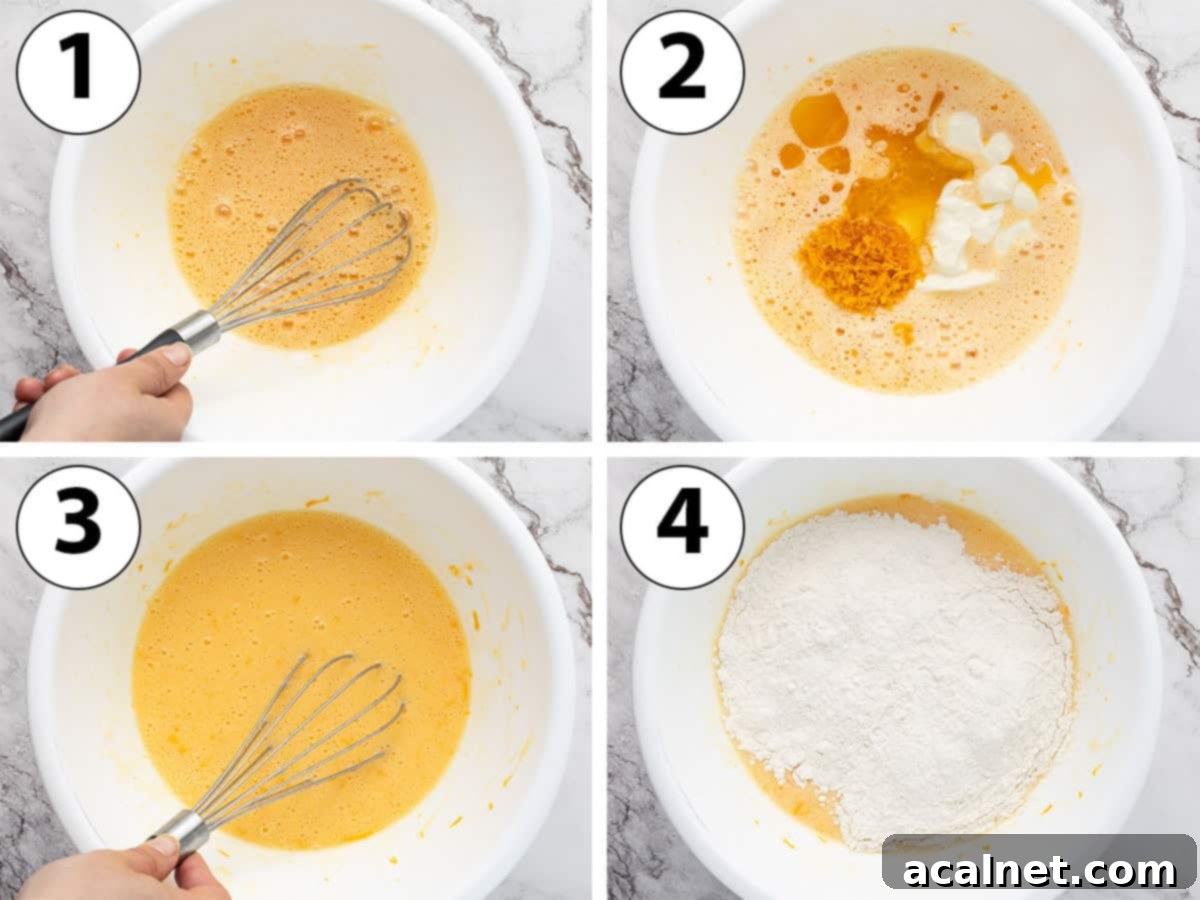
This recipe is designed to be incredibly straightforward, with easy-to-follow instructions that ensure a perfect result every time. The best part? No electric mixer is needed – just a bowl and a whisk!
- Prepare Your Pan & Preheat Oven: Begin by preparing a 25 cm (10-inch) loaf pan. Lightly grease it with a neutral oil spray or a thin layer of butter, then line it with baking paper (also known as parchment paper), leaving an overhang on the longer sides to easily lift the cake out later. If you prefer not to use baking paper, simply dust the greased pan with a little flour, tipping it over and tapping against a hard surface to remove any excess. Preheat your oven to 180 degrees Celsius (350 degrees Fahrenheit).
- Zest & Juice Your Oranges: Carefully zest your oranges, ensuring you only get the bright orange peel and avoid the bitter white pith. Then, slice the oranges in half and squeeze out the fresh juice. Set both the zest and juice aside, ready to infuse your cake with incredible flavor.
- Photo 1: Whisk Eggs & Sugar: In a large mixing bowl, combine the room temperature eggs and caster sugar. Whisk them together vigorously for a couple of minutes until the mixture becomes pale, slightly bubbly, and thickened. This step incorporates air, which contributes to the cake’s light and fluffy texture. For an even lighter crumb, you can whisk for 4 to 5 minutes until the mixture is truly light in color and more voluminous.
- Photo 2: Incorporate Wet Ingredients: Add the remaining wet ingredients to the egg and sugar mixture: the fresh orange juice, aromatic orange zest, neutral oil, and creamy Greek yogurt.
- Photo 3: Whisk Until Smooth: Lightly whisk all the wet ingredients together until they are well combined and the mixture appears smooth and homogenous.
- Photo 4: Add Dry Ingredients: Gently fold in the sifted self-rising flour. If you’re using all-purpose flour, this is when you’d add your pre-mixed dry ingredients (all-purpose flour, baking powder, baking soda, and salt).
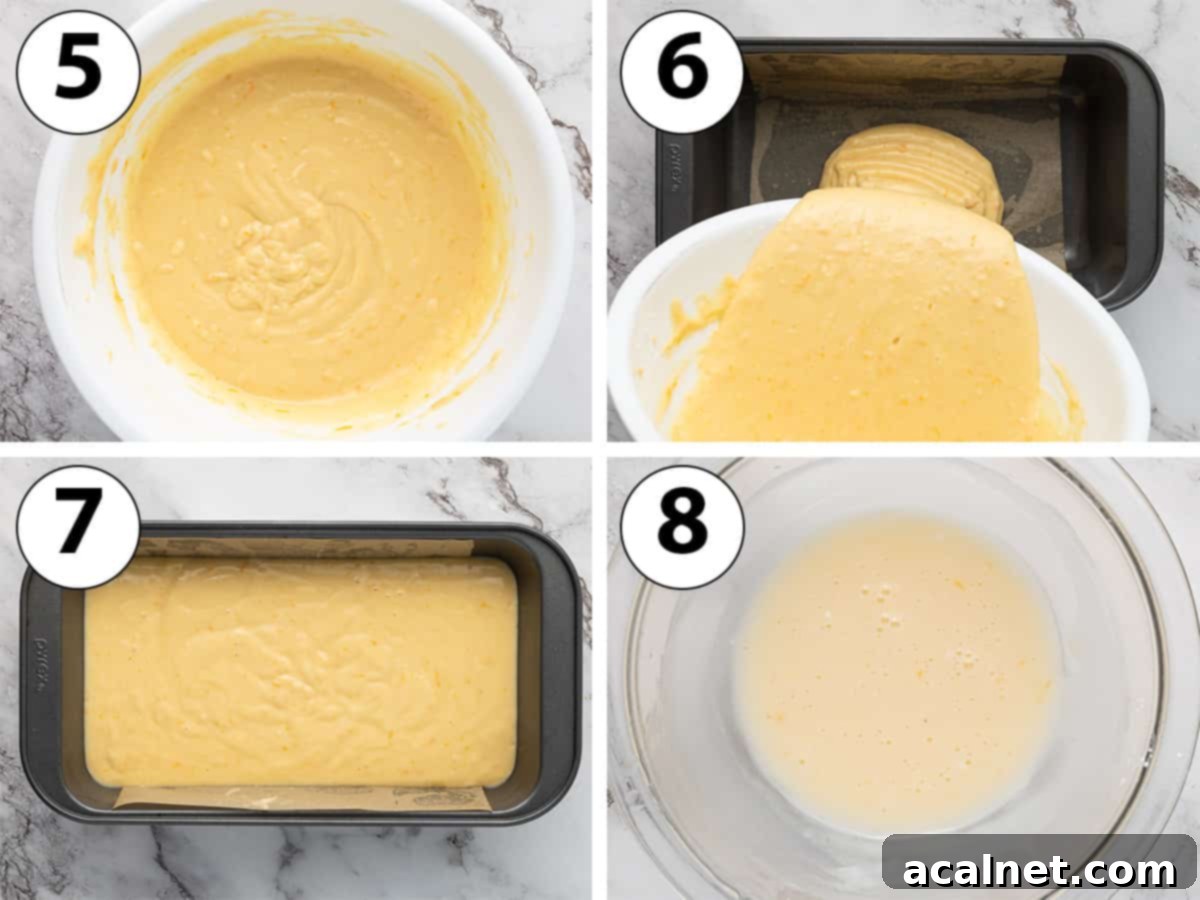
- Photo 5: Mix Until Just Combined: Continue to whisk the batter until the flour is just incorporated. It’s vital to avoid over-mixing, as this can develop the gluten in the flour too much, leading to a tough and dense cake rather than the desired soft and fluffy crumb. A few small lumps are perfectly fine!
- Photo 6: Pour into Loaf Pan: Carefully pour the gloriously orange-scented batter into your prepared loaf pan.
- Photo 7: Evenly Spread: Gently spread the batter around with a spatula to ensure an even layer, which will help the cake bake uniformly.
- Bake to Golden Perfection: Bake for approximately 40 minutes. The cake is done when it has beautifully risen, the top is a golden-brown color, and a wooden skewer or toothpick inserted into the center comes out with just a few moist crumbs clinging to it – not wet batter. Once baked, transfer the pan to a wire rack to cool down completely. This allows the cake to set and prevents it from steaming.
Pro Tip for a Clean Crack: For that classic, aesthetically pleasing crack down the center of your loaf, you have two options: either pipe a thin line of softened butter along the center of the batter before baking, or carefully remove the cake from the oven after about 5 to 10 minutes of baking and quickly slash the center with a sharp knife before returning it to the oven. This encourages the cake to rise evenly along the score line.
- Photo 8: Prepare & Apply the Orange Icing: While the cake cools, prepare your irresistible orange icing. In a small bowl, whisk together the well-sifted icing (powdered) sugar and fresh orange juice until you achieve a smooth, pourable liquid. Once the cake is completely cool – this is crucial, as a warm cake will cause the icing to melt and drip off – slowly pour or artfully drizzle the orange glaze over the top, letting it cascade down the sides for an elegant finish.
- Garnish & Serve: To complete your masterpiece and add another layer of fresh aroma, finish the cake with a generous sprinkle of additional orange zest. Slice and enjoy!
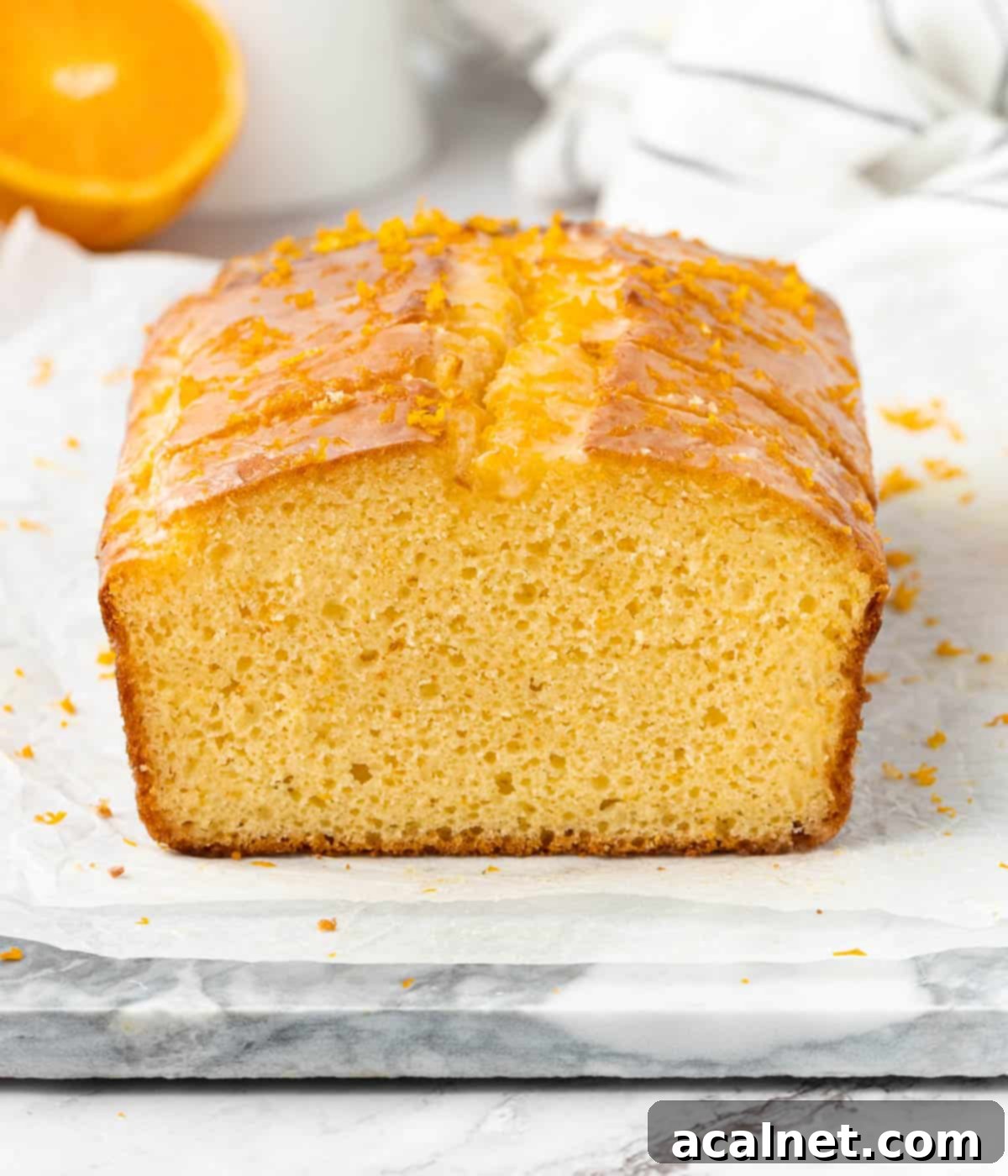
Common Questions About Baking Orange Loaf Cake
It’s incredibly simple to make your own self-rising flour at home if you only have plain or all-purpose flour on hand. For every cup (or 125g) of plain/all-purpose flour, add 1 ½ teaspoons of baking powder and ½ teaspoon of fine salt. Whisk these ingredients together thoroughly before adding them to your wet ingredients. For this specific recipe, you would use the same quantity of all-purpose flour (250gr or 1 2/3 cup) with the specified amounts of baking powder and salt.
Absolutely! The only dairy ingredient in this recipe is Greek yogurt. You can easily substitute it with a high-quality plant-based natural yogurt (such as coconut, almond, or soy yogurt). The key is to ensure you use a full-fat, unsweetened variety, as light or fat-reduced yogurts may alter the cake’s texture and moistness. Avoid flavored yogurts, as they will change the overall taste profile.
Since we are utilizing a significant amount of orange zest, it’s highly recommended to choose organic and/or unwaxed oranges whenever possible. This ensures you’re zesting pure, unadulterated flavor without any chemical residues. For juicing, Navel Oranges, Cara Cara, or Valencia Oranges are excellent choices, known for their abundant juice and sweet-tart balance. Whichever variety you pick, make sure they feel heavy for their size, indicating they are juicy.
While a simple orange icing is wonderfully delicious, you have many options to customize your loaf! For a truly decadent dessert, you could top the loaf with a homemade orange curd, providing a rich, tangy topping. Another idea is a luscious orange syrup, made by reducing orange juice with a touch of sugar in a small saucepan until it thickens. For a lighter touch, a dollop of freshly whipped cream is always a winner. And for chocolate lovers, a velvety chocolate frosting, like a whipped ganache, creates a divine flavor pairing with orange.
A dry cake can often be attributed to a few factors. Over-mixing the batter is a common culprit, as it develops the gluten too much, leading to a tough, dry texture. Over-baking is another major reason; even a few extra minutes in the oven can strip the cake of its precious moisture. Ensure your oven temperature is accurate (consider using an oven thermometer) and always check for doneness with a toothpick that comes out with moist crumbs, not completely clean. Using cold ingredients or a low-fat yogurt can also impact moisture, so stick to room-temperature ingredients and full-fat yogurt.
Absolutely! This orange loaf cake is a fantastic base for customization. Fresh or frozen cranberries, blueberries, or even chopped dates would be wonderful additions. If using frozen fruit, toss it lightly in a tablespoon of flour before adding to the batter to prevent it from sinking to the bottom. For a hint of indulgence, chocolate chips (dark, milk, or white) pair surprisingly well with orange. Just stir about ½ to ¾ cup of your chosen additions into the batter right before pouring it into the pan.
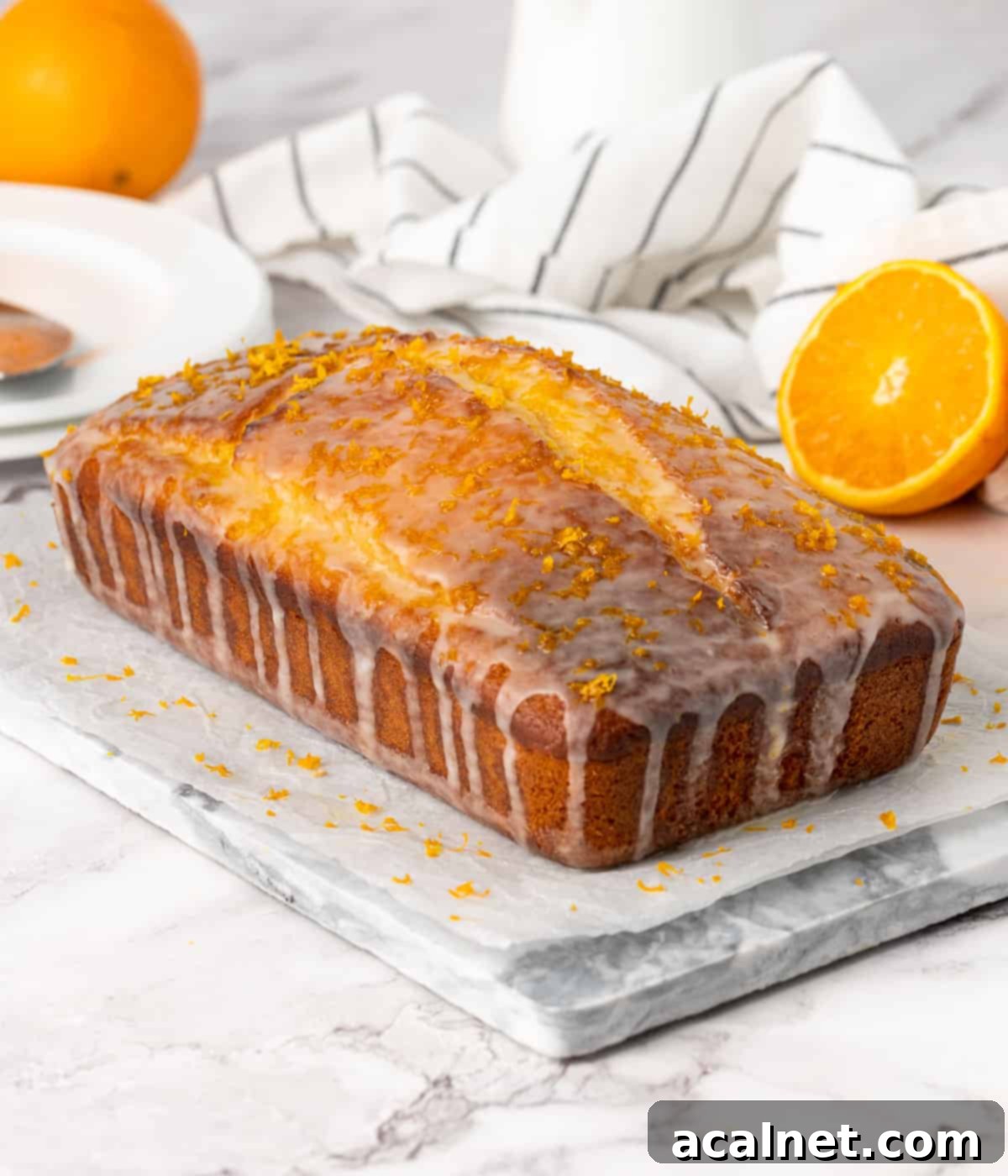
Expert Tips for Baking Your Best Orange Loaf Cake
- How to Pick the Best Oranges: When selecting oranges for this recipe, look for ones that feel heavy for their size – this indicates a high juice content. They should be slightly firm, have a smooth skin, and emit a fragrant, fresh aroma. Opt for organic or unwaxed oranges if possible, especially since you’ll be using the zest.
- The Best Way to Zest Citrus: For superior flavor and texture in your cake, a microplane zester (or a similar fine grater) is your best friend. This tool produces very thin, delicate strands of zest that disperse beautifully throughout the cake batter. This ensures that the intense orange flavor is evenly distributed without any noticeable, chewy bits of zest in the final bite.
- Achieving a Perfect Central Crack: Many prefer the rustic, appealing look of a perfect crack down the center of their loaf cake. To achieve this, you can either pipe a thin line of softened, unsalted butter directly down the middle of the batter before placing the pan in the oven, or, for an even cleaner line, take the cake out after about 5 minutes of baking and quickly score the center with a sharp knife (about 1/2 inch deep) before returning it to finish baking.
- Ensure Cake is Completely Cool Before Icing: This tip is critical for a beautiful glaze. If your cake is even slightly warm, the icing will not set properly; instead, it will melt, become transparent, and drip straight off the sides. Patience is key here – allow the cake to cool down thoroughly on a wire rack for at least 1-2 hours, or until it’s completely at room temperature.
- Adjusting Icing Consistency: The simple glaze in this recipe is intentionally on the thinner side for a light, elegant drizzle. If you prefer a thicker, more opaque icing, simply add more sifted icing sugar, a tablespoon at a time, whisking until you reach your desired consistency. For a thinner glaze, add a few drops more orange juice or water.
- Don’t Overmix the Batter: Once you add the flour, mix only until the ingredients are just combined. Overmixing develops the gluten in the flour, which can lead to a tough, rubbery cake. A few small lumps are perfectly acceptable and often indicate a tender crumb!
- Room Temperature Ingredients: As mentioned, eggs should be at room temperature. This applies to yogurt too! Room temperature ingredients emulsify better, creating a smoother batter and a more evenly textured cake. If you forget to take them out, place eggs in a bowl of warm water for 5-10 minutes, and warm yogurt slightly in the microwave (being careful not to cook it).
Storing & Freezing Your Orange Loaf Cake for Lasting Freshness
This delightful orange loaf cake is known for its impressive ability to stay fresh and moist for several days, thanks to the oil and Greek yogurt in the recipe. To maintain its optimal quality:
Storage at Room Temperature: The cake can be kept at room temperature for up to 2 days. To prevent it from drying out, ensure it’s well-covered with plastic wrap, aluminum foil, or stored inside an airtight container. Keep it away from direct sunlight or heat sources.
Refrigeration: While it will last longer in the fridge (up to 4-5 days), refrigeration can sometimes alter the texture of cakes, making the crumb slightly drier. If you do refrigerate, ensure it’s tightly wrapped to seal in moisture, and let it come closer to room temperature before serving for the best flavor and texture.
Freezing for Later Enjoyment: This cake freezes beautifully! You can freeze the entire loaf or individual slices, which is perfect for portion control. However, it’s crucial to freeze the cake *without* the orange icing. The icing’s consistency can change upon thawing, becoming watery or grainy. To freeze, wrap the cooled, un-iced loaf or slices tightly in plastic wrap, then an additional layer of aluminum foil to prevent freezer burn. It can be stored in the freezer for up to 2-3 months.
Defrosting: When you’re ready to enjoy, simply transfer the frozen cake (or slices) to room temperature and let it thaw for a few hours. Once fully defrosted, you can then prepare and drizzle the fresh orange icing over it for that final burst of flavor and a beautiful presentation.
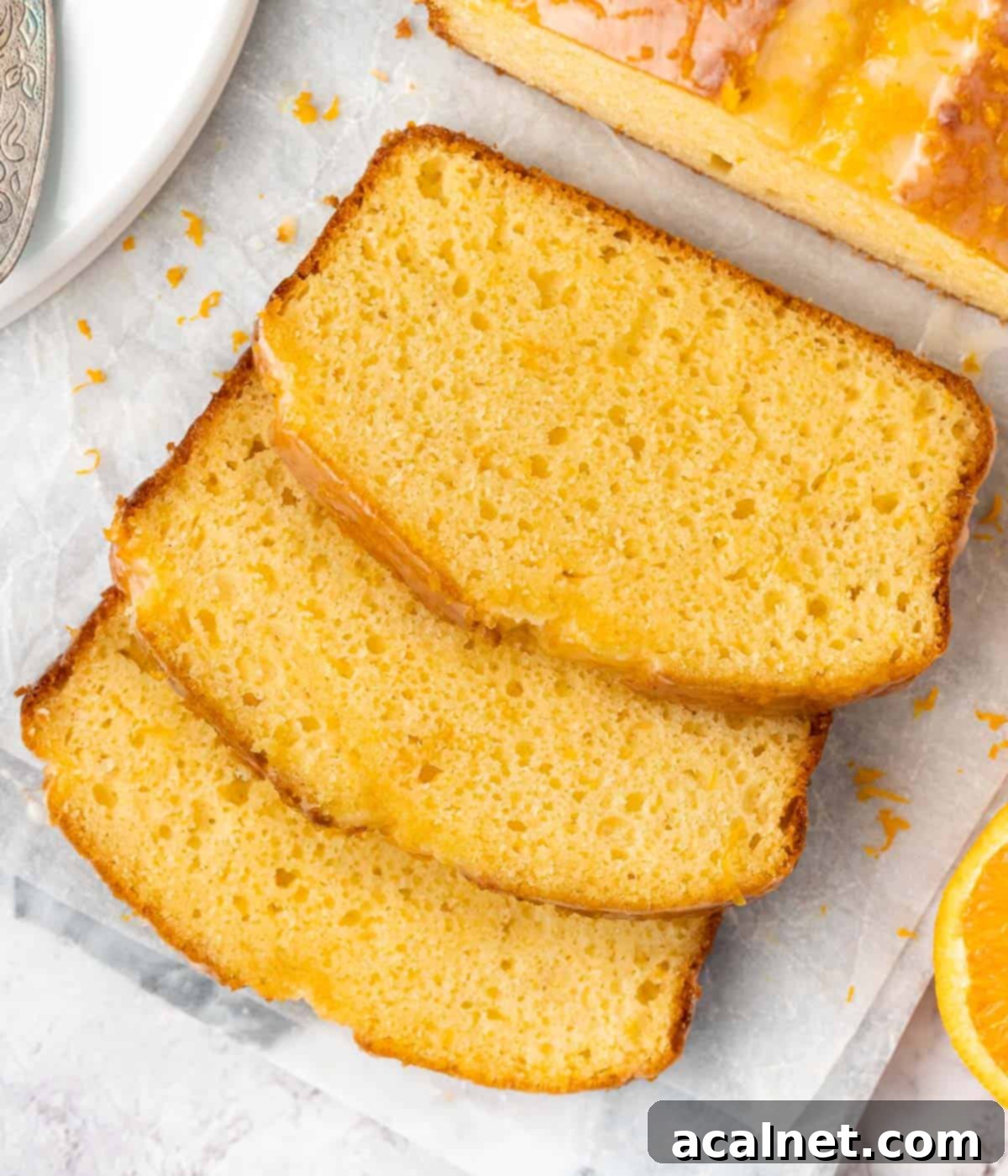
Explore More Delicious Loaf Cake Recipes
- Chocolate Loaf Cake
- Easy Marble Loaf Cake
- Apple Loaf Cake
- Carrot Loaf Cake
- Chocolate Chip Loaf Cake
- Coffee Loaf Cake
- Easy French Yogurt Cake (Gâteau au Yaourt)
- Pistachio Raspberry Loaf Cake
Have you baked this fantastic Orange Loaf Cake?
We’d absolutely love to hear from you! Please let us know if you enjoyed it by leaving a comment below, and don’t forget to tag us on Instagram @a.baking.journey with a photo of your beautiful creation!
Recipe Card

Orange Loaf Cake
Print Recipe
Ingredients
Orange Cake
- 2 teaspoon Orange Zest, about 2 oranges, finely zested
- 120 ml (1/2 cup) Fresh Orange Juice
- 100 gr (1/2 cup) Caster Sugar
- 3 large Eggs, at room temperature
- 80 ml (1/3 cup) Canola Oil, or other neutral cooking oil like vegetable or grapeseed oil
- 120 ml (1/2 cup) Greek Yogurt, or full-fat natural unsweetened yogurt
- 250 gr (1 2/3 cup) Self-Rising Flour, sifted (see notes for alternative with all-purpose flour)
Orange Icing
- 100 gr (1 cup) Icing Sugar, powdered sugar, sifted
- 15 ml (1 tablespoon) Orange Juice, freshly squeezed
- Orange Zest to garnish, to taste, for final topping
Instructions
Orange Cake
- Lightly grease a 25 cm (10-inch) loaf pan with oil and line it with baking paper/parchment paper, allowing an overhang on the long sides. Preheat your oven to 180 degrees Celsius (350 degrees Fahrenheit).
- Zest the oranges, then slice them in half and collect the fresh juice. Set both aside.
- In a large mixing bowl, vigorously whisk together the room temperature eggs and caster sugar for 2 to 3 minutes until the mixture is pale, bubbly, and slightly thickened (see Note 1 for a lighter crumb).
- Whisk in the fresh orange juice, orange zest, neutral oil, and Greek yogurt until smooth. Add the sifted self-rising flour (or your homemade blend, see Note 2) and mix gently until just combined. Avoid over-mixing the batter to ensure a tender cake.
- Pour the orange batter into the prepared loaf pan and gently spread it out into an even layer using a spatula.
- Bake for approximately 40 minutes, or until the cake has risen, the top is golden brown, and a wooden skewer or toothpick inserted into the center comes out with only a few moist crumbs (see Note 3 for a clean crack). Transfer the pan to a wire rack to cool down completely before removing the cake from the pan.
Orange Icing
- In a small bowl, sift the icing (powdered) sugar. Pour in the fresh orange juice and slowly whisk until you achieve a smooth, pourable liquid (see Note 4 for adjusting consistency). Once the cake is completely cool, pour or drizzle the icing generously over the top, allowing it to elegantly cascade down the sides.
- Finish the glazed cake with an additional sprinkle of fresh orange zest for a vibrant aroma and beautiful presentation. Slice and serve!
Would you like to save this recipe?
We’ll email this post to you, so you can come back to it later!
Notes
- For an even lighter and airier crumb texture, you can whisk the eggs and sugar for a longer duration – aim for 4 to 5 minutes – until the mixture significantly thickens and develops a lighter, pale yellow color.
- If you are using plain or all-purpose flour instead of self-rising flour, you can easily make your own blend. Use the same quantity of plain/AP flour (250g or 1 2/3 cups) and mix in 1 ½ teaspoons of baking powder, ½ teaspoon of baking soda, and a pinch of salt. Whisk these dry ingredients thoroughly before adding them to your wet batter.
- For a beautifully clean, defined crack along the top of your orange loaf, you have an optional step: after the cake has baked for about 5 to 10 minutes, carefully remove it from the oven and make a shallow, approximately ½-inch deep, lengthwise slash down the center with a sharp knife. Return it to the oven to complete baking.
- The orange icing in this recipe is designed to be a relatively thin glaze for a delicate finish. If you prefer a thicker, more opaque icing, simply increase the quantity of sifted icing sugar, adding it gradually spoonful by spoonful until your desired consistency is achieved. For a thinner glaze, add a few extra drops of orange juice.
Nutrition (per serving)
